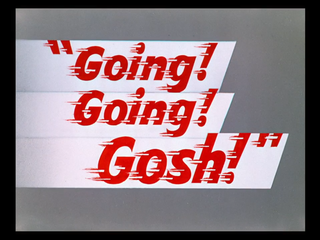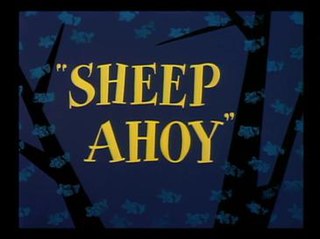Related Research Articles

Wile E. Coyote and the Road Runner are a duo of cartoon characters from the Looney Tunes and Merrie Melodies series of animated cartoons, first appearing in 1949 in the theatrical cartoon short Fast and Furry-ous. In each episode, the cunning, devious and constantly hungry coyote repeatedly attempts to catch and subsequently eat the Road Runner, but is always humorously unsuccessful in doing so. Instead of his animal instincts, the coyote uses absurdly complex contraptions to try to catch his prey. They comically backfire, with the coyote often getting injured in slapstick fashion. Many of the items for these contrivances are mail-ordered from a variety of companies implied to be part of the Acme Corporation.
Hopalong Casualty is a 1960 Warner Bros. Looney Tunes theatrical animated short, directed by Chuck Jones. The short was released on October 8, 1960, and stars Wile E. Coyote and the Road Runner. The title is a play on the Hopalong Cassidy western series of books written by author Clarence E. Mulford.

Fast and Furry-ous is a 1949 Warner Bros. Looney Tunes cartoon, directed by Chuck Jones and written by Michael Maltese. The short was released on September 17, 1949, and stars Wile E. Coyote and the Road Runner, in their debut.

To Beep or Not to Beep is a Merrie Melodies animated short starring Wile E. Coyote and the Road Runner. Released on December 28, 1963, the cartoon was written by Chuck Jones, John Dunn, Michael Maltese, and directed by Jones, Maurice Noble and Tom Ray receive credit as co-directors. This is the penultimate Road Runner/Wile E. Coyote short that Chuck Jones directed at Warner Bros. during the original "classic" era. This is also the final Warner Bros. cartoon released in 1963.
Paul Hull Julian was an American background animator, sound effects artist and voice actor for Warner Bros. Cartoons. He worked on Looney Tunes short films, primarily on director Friz Freleng's Sylvester and Tweety Bird shorts.

The Bugs Bunny/Road Runner Movie is a 1979 American animated comedy package film directed by Chuck Jones, consisting of a compilation of classic Looney Tunes/Merrie Melodies shorts and newly animated bridging sequences hosted by Bugs Bunny. The bridging sequences, which had been produced in 1978, show Bugs at his home, which is cantilevered over a carrot-juice waterfall. The film was released to celebrate the 40th anniversary of Bugs Bunny.
The Wild Chase is a Warner Bros. Merrie Melodies short directed by Friz Freleng and Hawley Pratt. The short was released on February 27, 1965, and stars Speedy Gonzales, Sylvester and Wile E. Coyote and the Road Runner. This cartoon was the only Wile E. Coyote/Road Runner cartoon to be directed by Freleng or Pratt, who specialized in Speedy and Sylvester cartoons. It is also noted as a crossover between the Sylvester/Speedy and Wile E. Coyote/Road Runner cartoons.
Lickety-Splat is a 1961 Warner Bros. Looney Tunes theatrical animated short directed by Chuck Jones and Abe Levitow. The short was released on June 3, 1961, and stars Wile E. Coyote and the Road Runner.

Going! Going! Gosh! is a 1952 Warner Bros. Merrie Melodies cartoon directed by Chuck Jones. The short was released on August 23, 1952, and stars Wile E. Coyote and the Road Runner.

Zipping Along is a 1953 Warner Bros. Merrie Melodies cartoon directed by Chuck Jones. The short was released on September 19, 1953, and stars Wile E. Coyote and the Road Runner.

Stop! Look! And Hasten! is a 1954 Warner Bros. Merrie Melodies cartoon, directed by Chuck Jones. The short was released on August 14, 1954, and stars Wile E. Coyote and the Road Runner. The title is a play on the railroad crossing safety phrase "stop, look, and listen". The cartoon has been featured in the film The Shining. Danny Torrance and his mother, Wendy Torrance, are seen watching this cartoon.

Guided Muscle is a 1955 Warner Bros. Looney Tunes cartoon directed by Chuck Jones. The short was released on December 10, 1955, and stars Wile E. Coyote and the Road Runner.

Scrambled Aches is a 1957 Warner Bros. Looney Tunes cartoon directed by Chuck Jones. The short was released on January 26, 1957, and stars Wile E. Coyote and the Road Runner. The title is a pun on scrambled eggs.

Whoa, Be-Gone! is a 1958 Warner Bros. Merrie Melodies cartoon directed by Chuck Jones. The short was released on April 12, 1958, and stars Wile E. Coyote and the Road Runner.
Hot-Rod and Reel! is a 1959 Warner Bros. Looney Tunes cartoon directed by Chuck Jones. The script was written by Michael Maltese, and the film score was composed by Milt Franklyn.

Gee Whiz-z-z-z-z-z-z is a 1956 Warner Bros. Looney Tunes cartoon directed by Chuck Jones. The short was released on May 5, 1956, and stars Wile E. Coyote and the Road Runner.

Sheep Ahoy is a 1954 Warner Bros. Merrie Melodies cartoon directed by Chuck Jones. The short was released on December 11, 1954, and stars Ralph Wolf and Sam Sheepdog.
This is a listing of all the animated shorts released by Warner Bros. under the Looney Tunes and Merrie Melodies banners between 1960 and 1969. A total of 147 shorts were released during the 1960s.
Rushing Roulette is a 1965 Warner Bros. Merrie Melodies cartoon directed by Robert McKimson. The short was released on July 31, 1965, and stars Wile E. Coyote and the Road Runner. It was the second Road Runner cartoon directed by someone other than Chuck Jones, who had almost exclusively used the characters since their debut in 1949. McKimson directed one other Road Runner cartoon the following year, Sugar and Spies.
Clippety Clobbered is a 1966 Warner Bros. Looney Tunes theatrical animated short directed by Rudy Larriva. The short was released on March 12, 1966, and stars Wile E. Coyote and the Road Runner.
References
- ↑ Beck, Jerry; Friedwald, Will (1989). Looney Tunes and Merrie Melodies: A Complete Illustrated Guide to the Warner Bros. Cartoons. Henry Holt and Co. p. 359. ISBN 0-8050-0894-2.
- ↑ Lenburg, Jeff (1999). The Encyclopedia of Animated Cartoons. Checkmark Books. pp. 128–129. ISBN 0-8160-3831-7 . Retrieved 6 June 2020.